I haven’t made an ice cream bombe, and I don’t plan to while I’m here but Rory demo’d one on Friday and honestly I can’t pass up that pun-portunity.
Our time in this bubble grows short. This was our last full week of cooking! We’ll do one more cook on Monday, then it is prepping for the practical and written exams and then home in less than a week.
That’s gonna be weird.
Meanwhile there is an air of giddiness across the place, that not even the cool temps and occasional rain can undermine. It is totally like the last week of school before summer vacation - spirits are high and people are friendly but unlike the week before summer vacation in the Cambridge Public School District, shit is actually getting done. We’ve got interesting ingredients and serious techniques and there’s a whole heckin’ lot of good cooking going on. But first, some ruminations about lamination.
You may have noticed that a lot of the things we cook here require a fair amount of time and effort and even bashing things about. Bread! We’re constantly either kneading the heck out of something or mixing quickly with a crab-hand so as to not overwork the dough. Other techniques drive us mad with frustration (I’m looking at you, grape peeling), some just drive us to tears (that gd paper piping bag). But laminated dough is a host unto itself and as I’ve been deep in the hole with pastry this week, I’m thinking it offers an intriguing analogy for this long strange trip. So I hope you’ll indulge me with this next bit.
(Also, I’m making puff pastry for my practical exam, so need to nail down the steps.)
Puff pastry, or laminated dough for croissants and such, gets its spectacular flaky layers by rolling and folding and rolling and folding a sheet of butter inside a dough.1 When it is baked, the butter melts, the resulting steam makes the layers of pastry rise up, and the strong flour enables the resulting teeny pockets to hold their shape which is where the lovely crispness and flashy appearance come from. It isn’t that hard to make, and some people2 quite love the process. But it does have precise steps which must be followed to achieve superior results.
Before you get that lovely smooth dough, you have to start with the détrempe3 which for puff is just a dough of strong white flour,4 water, and a few drops of lemon juice. You mix it up with your hands and it is shaggy and messy and has to sit for half an hour before you do anything with it.
That’s us when we arrive at Ballymaloe and start the program - we’re trying to be all cheffy and cool but actually some of are a mess and others just need a timeout.
Meanwhile, you bash your pound of butter5 into submission with a rolling pin. Literally, you have to flatten that mf into a thinnish square that will completely fit in your rolled-out détrempe and you might have to do it in another room if all your kitchen equipment will jump about on the counter when you are doing the bashing.
The cheffers will separate from the cookers here because the former will probably have rulers handy and will make their butter square perfectly neat while others of us may have some woo-woo edges. The beaten-into-submission analogy should be obvious here.
Back to your détrempe, you roll that mess out into a rectangle, place your butter square in it, and then fold the dough over the butter like an envelope.6 You have to seal the butter in because that is the whole point, to contain the butter completely in dough so it won’t leak butter and lose layers when you bake it. There is no way around this if you are making classic puff pastry dough, you have to follow the correct process. Early-ish in the course, everyone - well, a lot of people - want to be doing things their way, taking their favorite little shortcuts, because we’re cooks we know what to do in a kitchen! Sometimes our ways work but often they don’t quite so we are repeatedly reigned in by our instructors, reminding us to do things as we’re taught, that there is a method to their madness. We are the butter, we are being gently encased in The Ballymaloe Way.
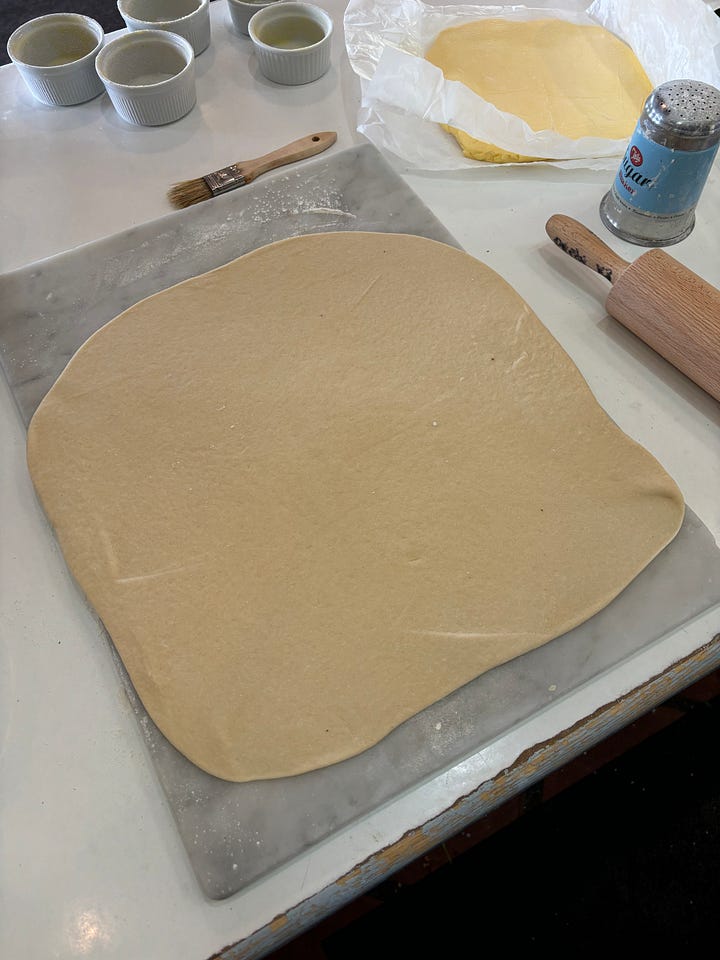
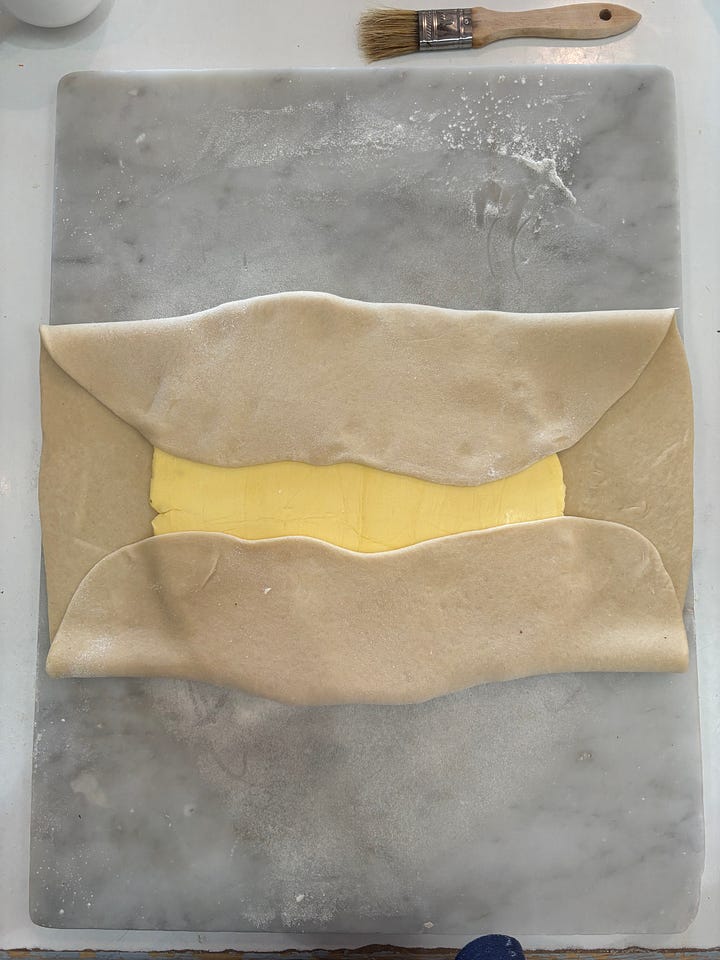
Now comes the laminating part. You roll the dough envelope into a long narrow rectangle, all the while moving it on the well-floured marble slab so it doesn’t stick. Your butter-in-dough, which was two layers of dough and one of butter, became three (because of the envelope), and now you’re going to do that again, and then again, so you are creating multiple layers of butter-in-dough.
Ideally, you do this all in a cool environment (Ireland in the analogy, obvs), so on a marble slab or in front of an open window or something. If it gets too warm, the butter might leak (oh, tears in the analogy), and you’ll have to put it in the fridge to cool off. After the first two folds, you chill it for half an hour, then you do the folds again, chill it again, then one more time and when it is cold after that, it is ready to use.
Folding and rolling and chilling, folding and rolling and chilling. Are you picking up what I’m putting down here?
When you are ready to bake, you might cut off a chunk, and it rolls into the most gorgeous, smooth, supple dough you’ve ever made. In the oven (as long as you flake the sides with a knife but don’t egg wash them) it will puff up into a billion flaky layers and turn gorgeously golden and you will look in the oven window as it bakes and say wow look at her go and you will feel like YOU are the greatest cooker in the world.
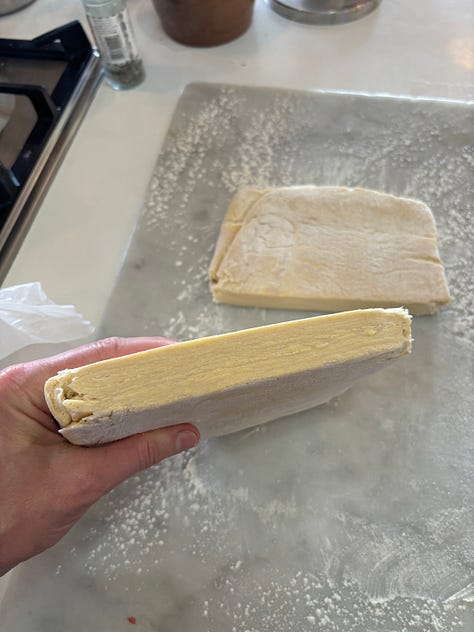
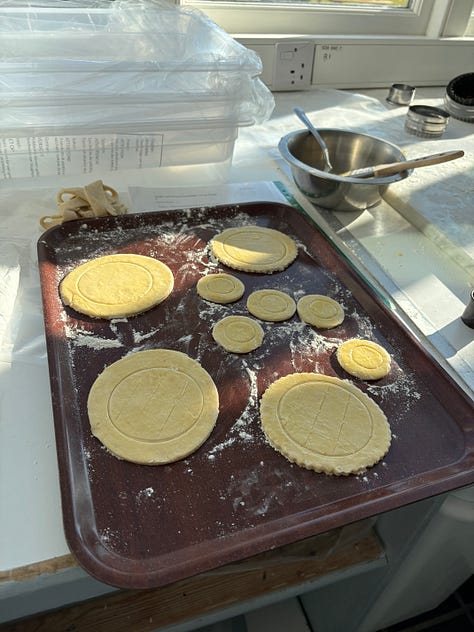
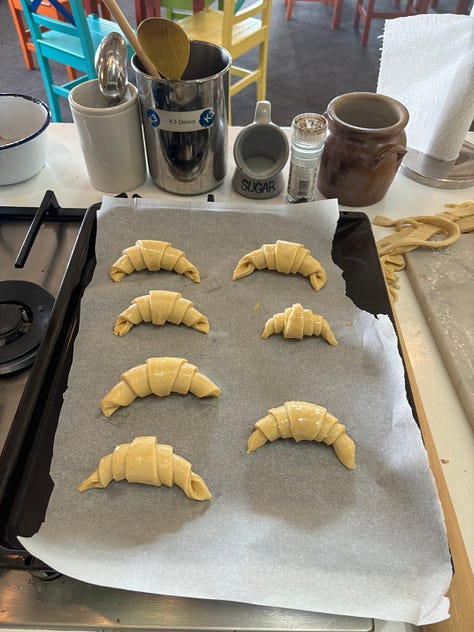
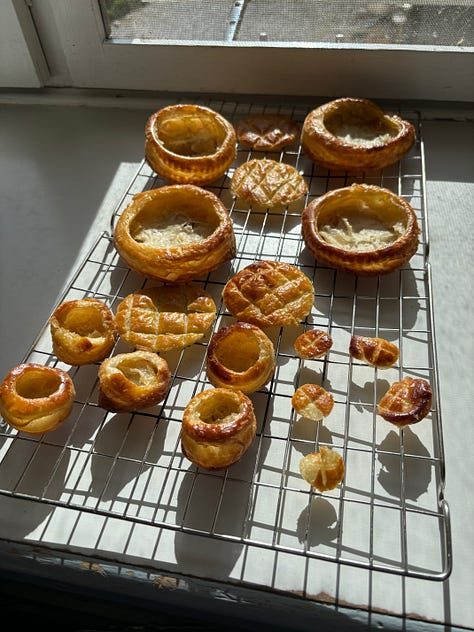
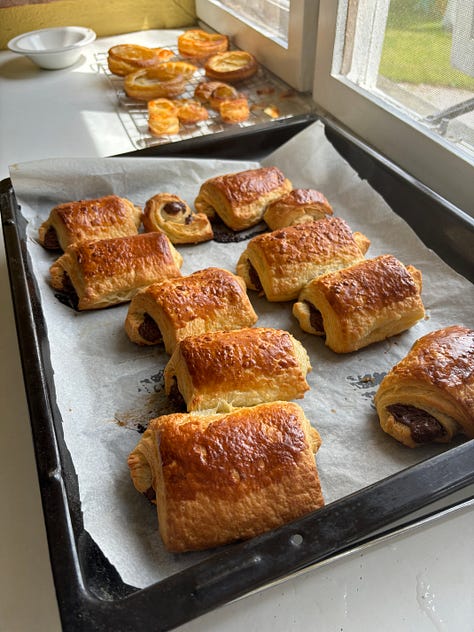
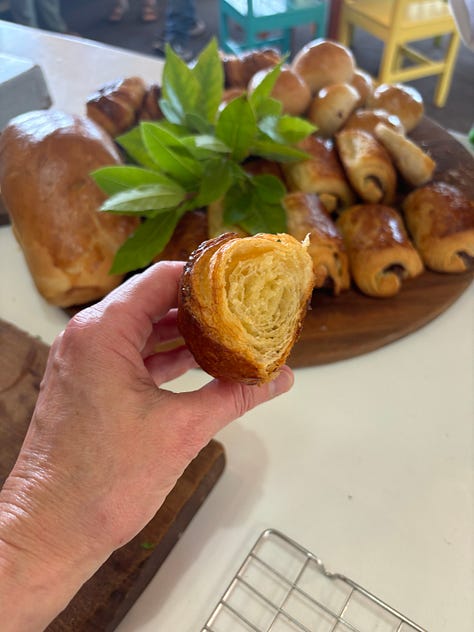
Many of us here started out very rough indeed, with more than a few drops of lemon juice in our détrempe if you know what I mean. But with the occasional bashing, the patient instruction, some cooling off periods, and then again, and again, we are now smooth operators in the kitchen, no leaks, ready to rise up and show off in the heat of our exams.
Did I strain that analogy a bit too much? Do you knead a break?
Thank you, I’ll only be playing here for one more week, folks!
This week I was in the demo part of Kitchen 3 which is a tiny space in front of the cirque de soleil room where we often have lunch. There are four of us there: me, my CDCÂ partner Vivi from England who seems a little anxious about her cooking, another British CDCÂ David who had the extreme good sense to just take it easy this week, and David’s housemate Amber who is a very good cook and extremely ambitious which drives everyone slightly bats but also you go girl. Vivi kept herself on a strict course, David was just cruising, which left me and Amber cooking our butts off in between.
And finally I’m in the zone and fucking crushing it. Really! I had some great cooks this week, and didn’t let the illegitimum get me carborundum. Where was this calm and confident cook ten or even three weeks ago? I guess it is good that I am peaking now, but would an extra week or two of Victor Laszlo Lisa have been so hard to deliver, universe?
Here’s first tracks in Kitchen 3 on Friday morning.
I’m not sure I’ve mentioned our Black Books but they are with us always and by now are stained and a bit crusty. These are small binders that contain various sheets where the instructors record our progress, offer comments on our cooks, sign off on duties, and most importantly, tick off the long list of techniques whenever we do one. These range from things like frying an egg (there is a Ballymaloe Way to do that, of course) to making puff pastry. There are dozens of them, and many say “at least once” which means you really should do those.
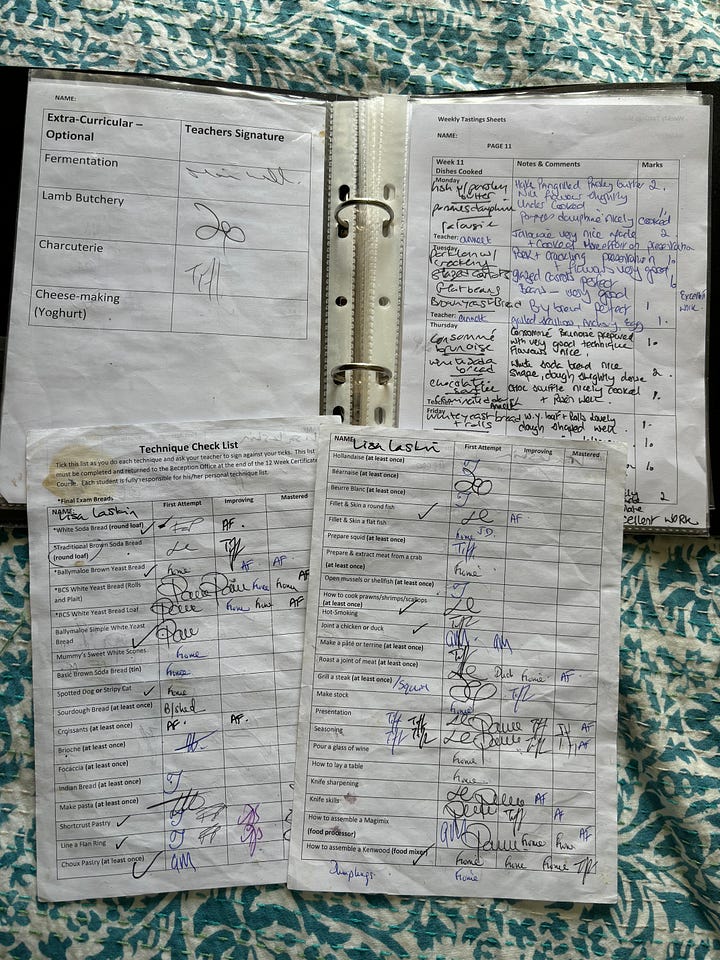
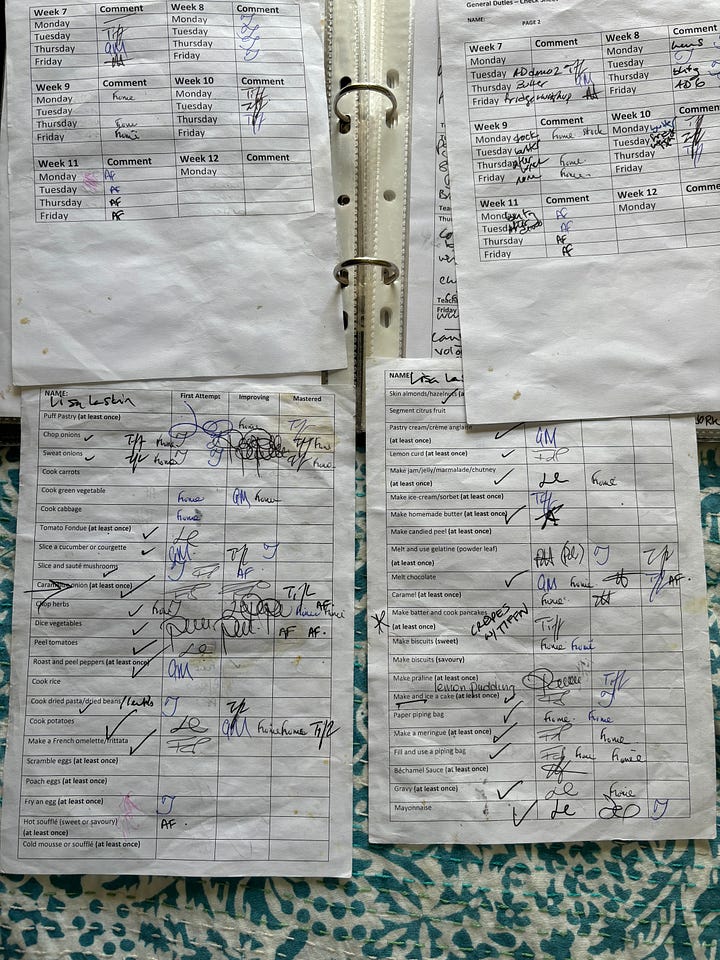
Amber is determined to get all the techniques in her black book ticked off and by god I think she has done it. Me, I’ve still got a few “at least once” ones blank, but as Teacher Annette said to me quietly this week when I was fretting about not having ticked off scrambling an egg “we do think you probably know how to scramble an egg.” In other words, don’t sweat the small stuff. Apparently very few people ever get all the techniques ticked off, and following Annette’s wise counsel, I have eschewed making candied peel7 in order to focus on bread practice. But good on ya, Amber!
Here are the cooking highlights:
pommes dauphine which are basically little deep-fried balls of mashed potato with some choux pastry mixed in and they take forever but with a sprinkle of salt good lord are they munchable
a jalousie tart which, yes, looks like the window shade and which I swear to god winked at me when I tried to cover up a blowtorch burn with a teeny daisy
another pork roast with crackling thank you Irish piggies and butchers!
a kind of odd-sounding but actually delicious starter of charred scallions with mushroom, anchovy, and egg
brown yeast bread, white yeast bread, white yeast rolls, white soda bread - why yes these are on the exam so we are all practice practice practicing and there is basically a mountain of bread around here right now
clear beef consomée brunoise the garnish for which is the teeny-tiniest dice imaginable of several separately cooked veg, fit for mice
a pretty goddamn perfect chocolate soufflé
lamb tagine with toasted almonds and preserved lemon
that laminated yeast dough from which came croissants and pains au chocolat
vol-au-vent filled with Calvados pastry cream and apple-sweet geranium compote which is a puff pastry case with sweet deliciousness in it
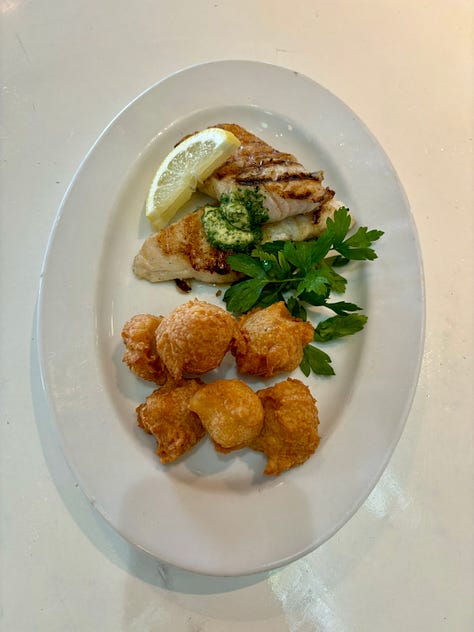
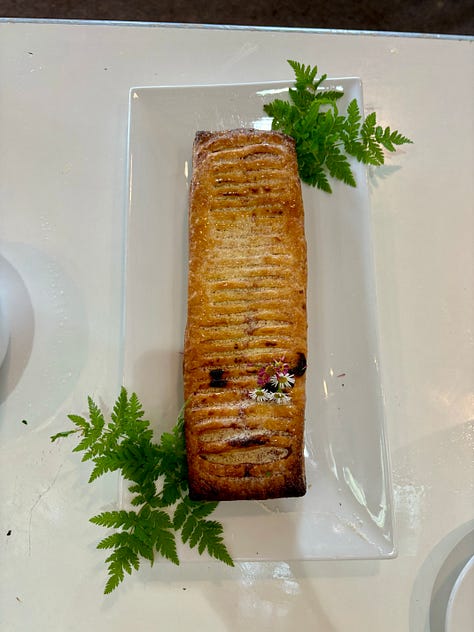
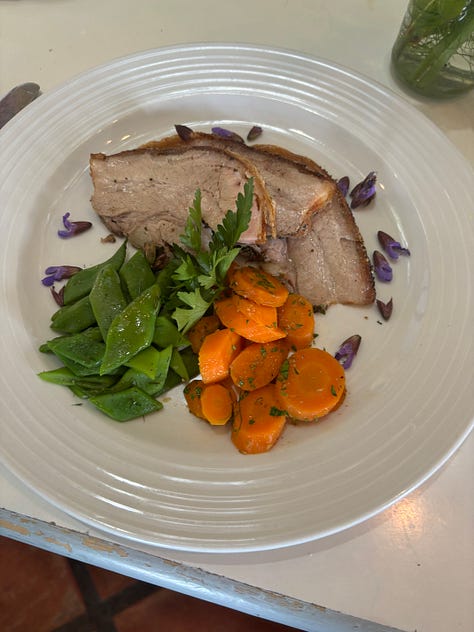
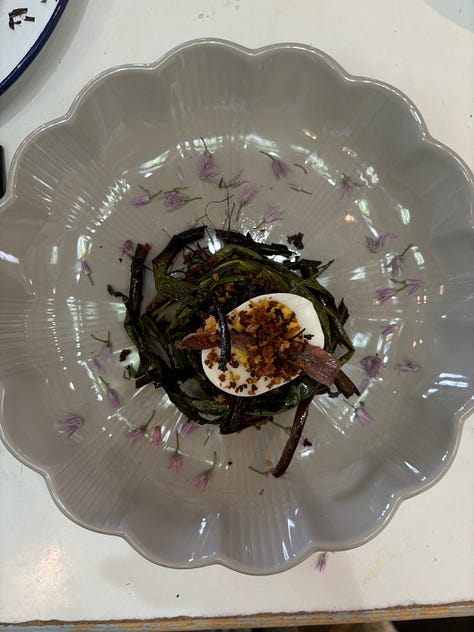
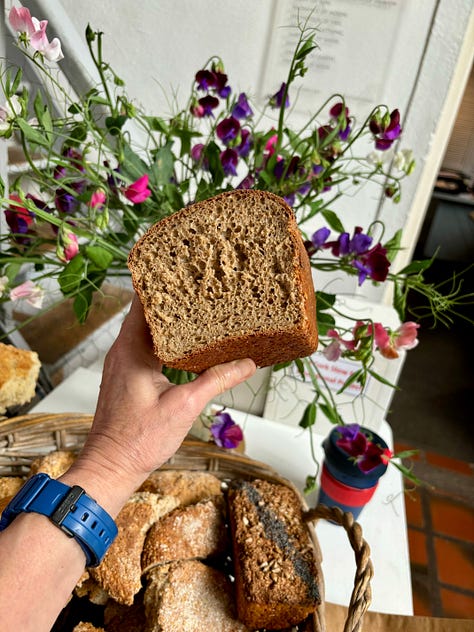
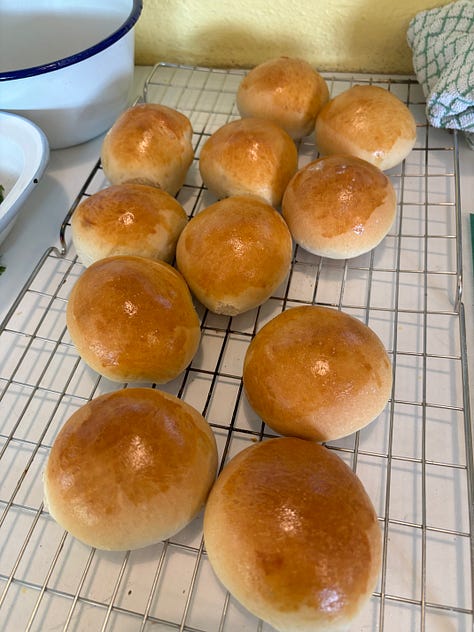
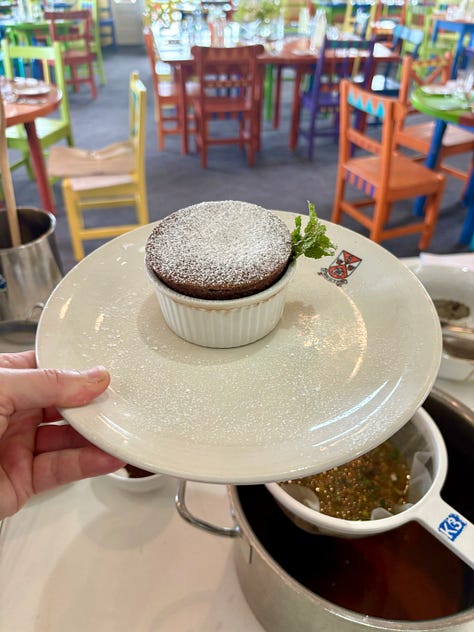
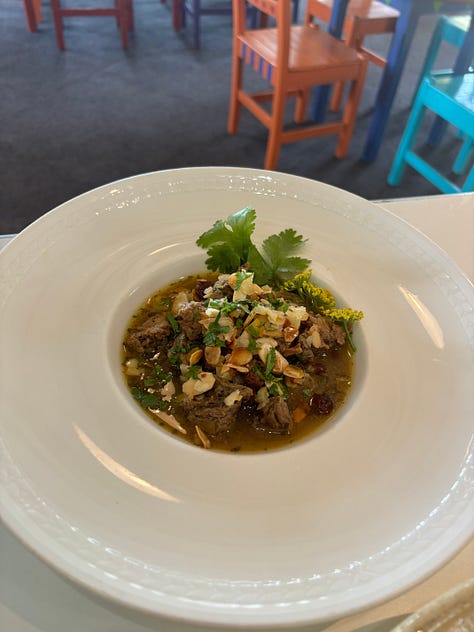
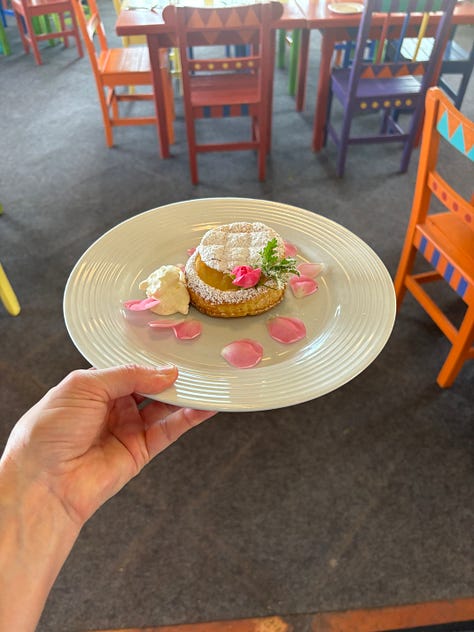
pommes dauphine, that sassy jalousie, pork 'n beans, charred scallions etc., brown yeast bread with a background of sweet peas, white yeast rolls, choco soufflé, lamb tagine, the long-winded vol-au-vents
So many technique ticks this week!
In other news, Wednesday morning our wine exam was at 8 a.m. SHARP. We had to wear our whites, which was kind of silly because we don’t cook on Wednesdays so everyone changed back into their civvies immediately afterward. It was 100 multiple choice questions on things like the proper sherry pairing with Jamon Iberico, the correct serving temperature for champagne and sweet wines, where do tannins come from, what pest destroyed European grape vines in the early 1870s to the point where they ALL had to be saved by grafting on ‘Murican rootstock, and so on.8 I’m sure I passed but doubt there was much distinction there because other than riddling and the grape variety for Prosecco (Glera) I kind of forgot to study the whole sparkling situation. Fortunately the wine exam is not required but you know, I learned a few interesting things in the class and if I passed at all I’m happy with that.
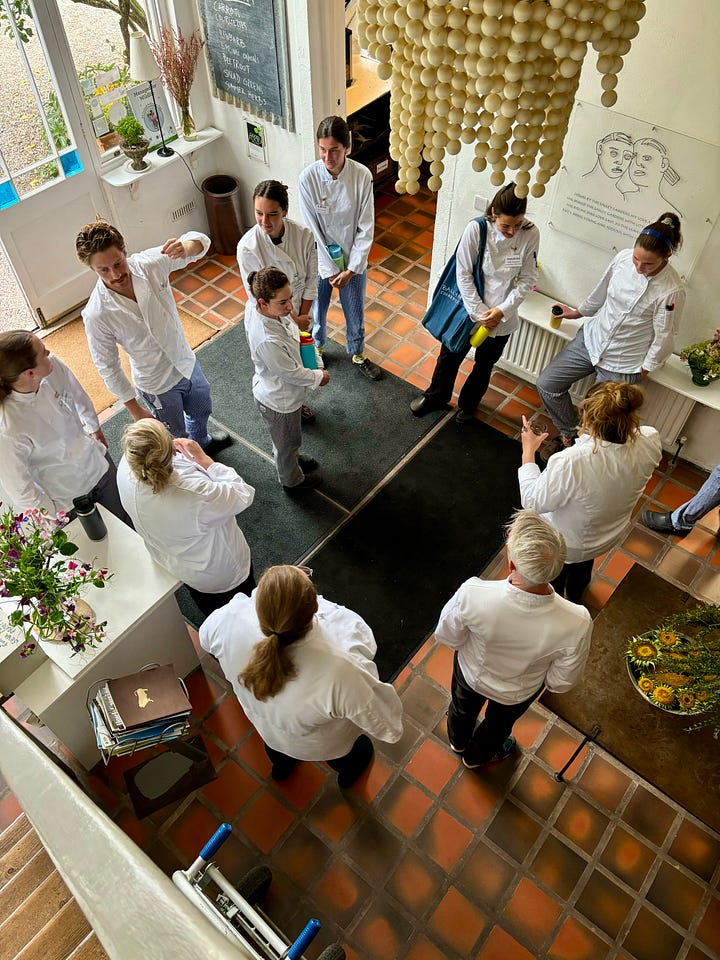
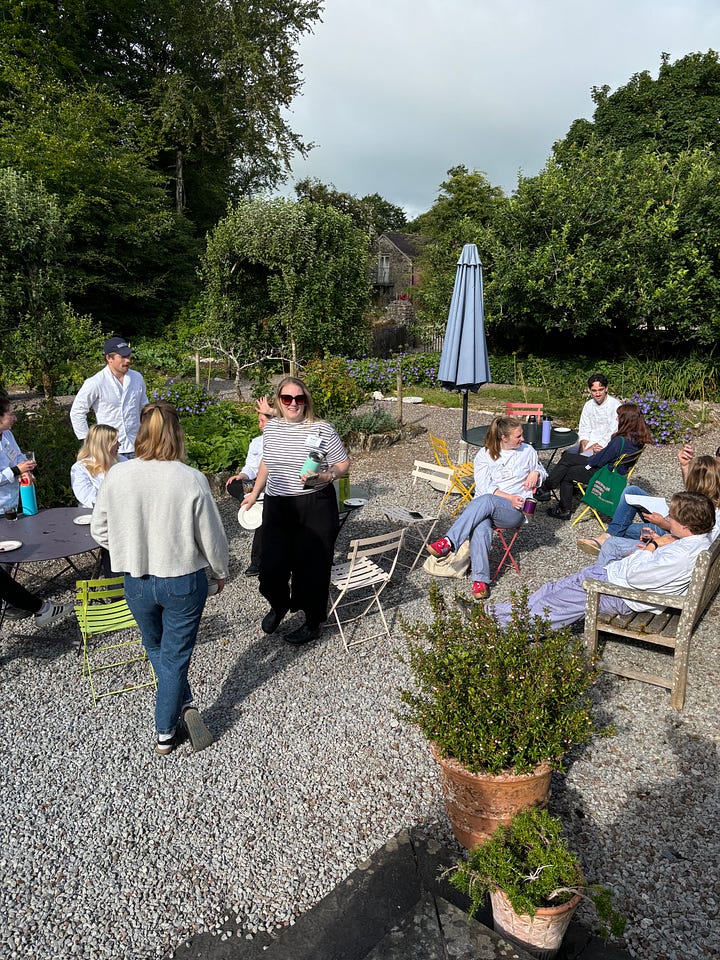
Now all eyes turn to the practical and written exams next week. This is all I need to know NBD.
But there may be a little fun before we hit the books so stay tuned 😎
They are in fact two different doughs. All puff pastry is laminated, but the détrempe for croissants etc. is a little richer, with melted butter and a little yeast in the initial mix.
Rory O’Connell, for one. He keeps asking us how many of us love making puff pastry, hoping for more recruits to his flaky army.
So interesting that Substack indicates a possibly misspelled word on absolutely existing words like détrempe. And even on its own name!
Remember, class, strong flour is the one with all the protein and gluten so whatever you are making with it will have a good structure. it’s like the bones of the bread and we all want good bones, right?
Don’t go getting all a pound of butter! on me, this makes a lot of dough but it freezes well so just put a cork in it and enjoy the finished product.
In the old days, I might have said that this signified all the letters we were sending home filled with tears but nowadays we just FaceTime so that one really doesn’t work.
This is what you do with your oranges and lemons that have been juiced or whatever but still have perfectly good rinds. It involves soaking the peels for a day, then boiling them for three hours until soft, then cooking them in a sugar syrup to the thread stage and the peels look translucent. You store in the syrup and use it in all manner of things for a bittersweet fruity punch or dry it and crystallize it, and use it as deco. It is a very good thing to do and to have but it is a PITA to make and Wise Annette also said that it’s just on the list so you have a chance to try it, don’t worry about it. Some people found Annette a little challenging to work with because she was always disappearing to get something but I think she is kind and wise and she has a very calm demeanor and lovely accent. Also, she gave me a lot of 1s, so, yeah.
Fino (I think?), 6-8 degrees C, grape skins mostly, Phylloxera. And you thought we just bailed ‘em out in WW1 and WW2.




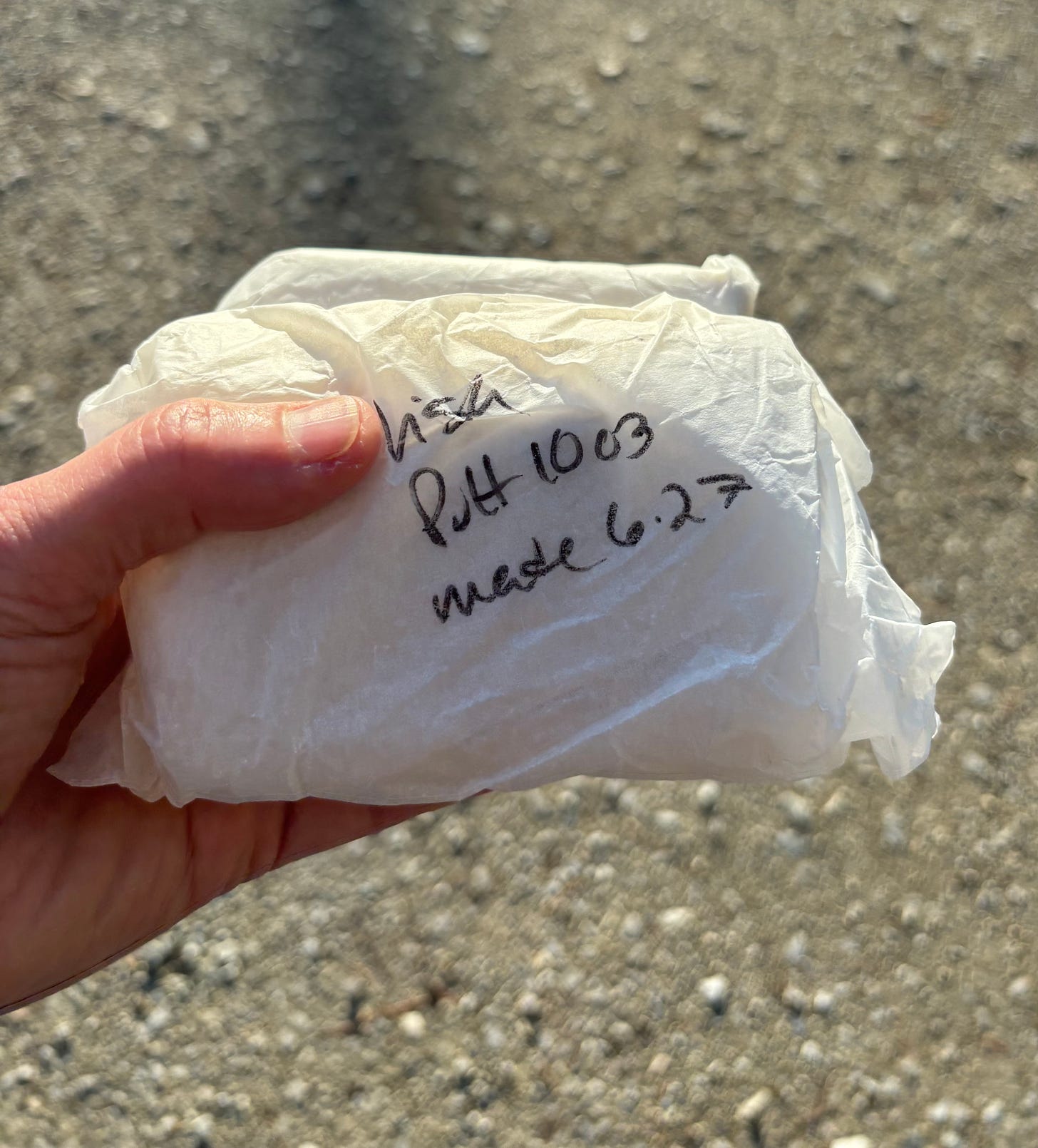
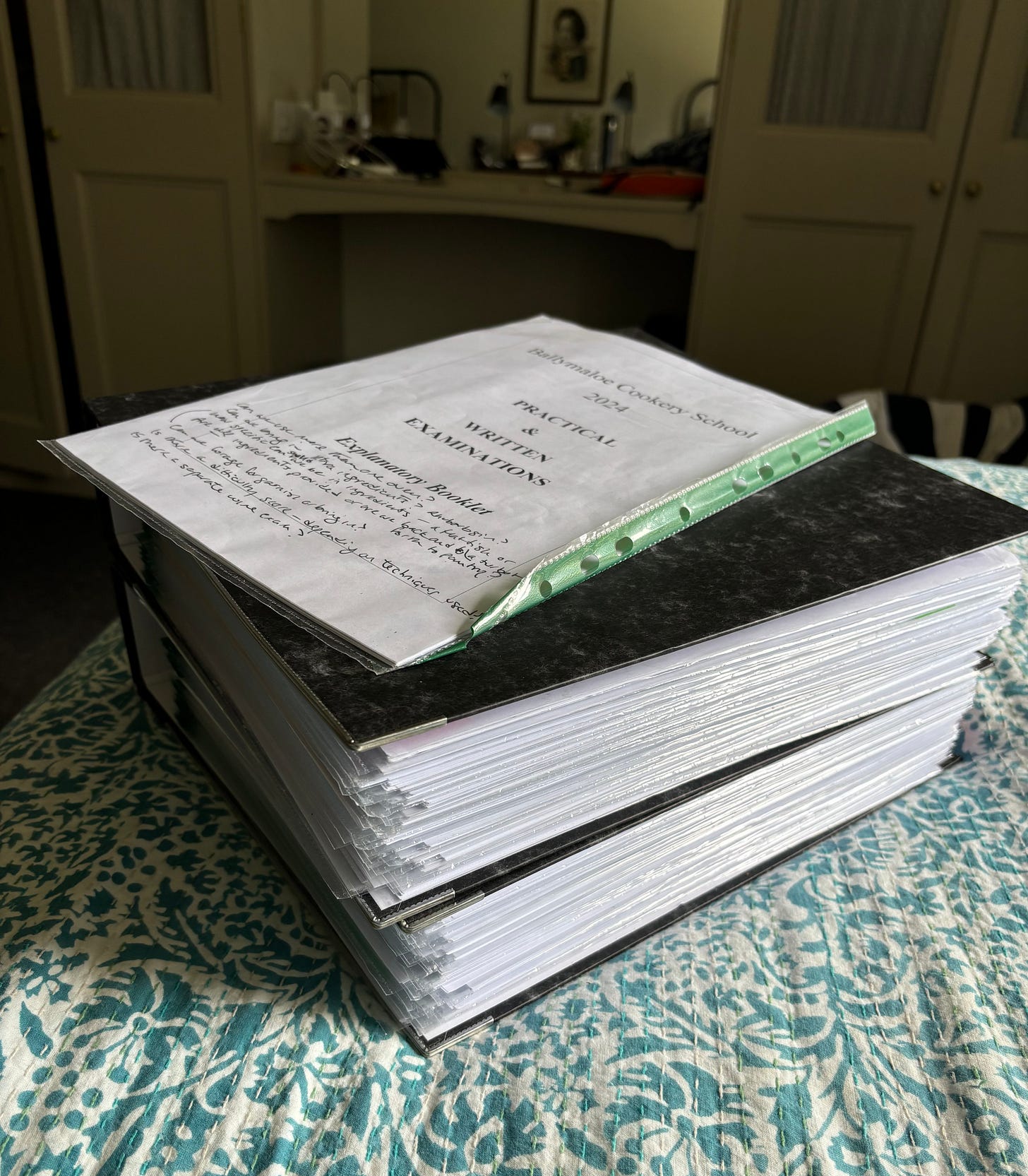
Second note: I am by no means an adventurous or "fancy" eater, but am really intrigued by the salty goodness and umami of those scallions and egg with the little fishy. That sounds incredible.
That dough is gorgeous! You forgot to mention: you can't use your hands. Maddening. Enough to make you hate the French, except... omg delightful when it's done. Really nice work. And your yeast rolls are perfection.